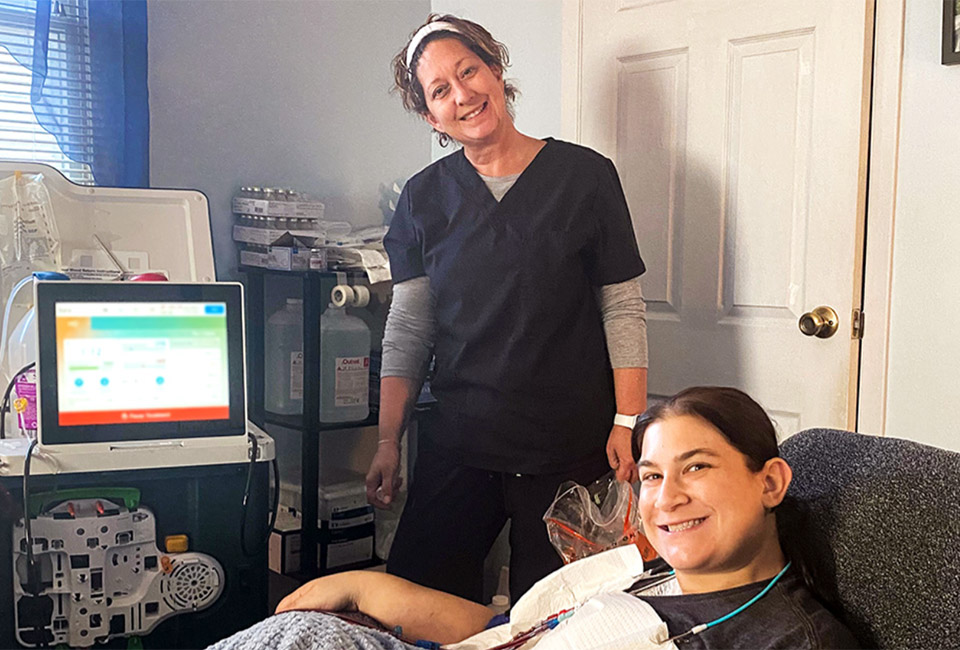Advancing Home Dialysis: A Patient-Centered Approach with Tablo
Discovering you are in kidney failure can be a long, slow process — or it can happen all of a sudden, seemingly out of nowhere. One minute it’s a normal day, then the next minute you’re being rushed to the emergency room, where tests reveal that your kidneys are failing and you’re told that you will need to begin dialysis several times a week, for several hours per session, in order to stay alive.
Dialysis — a treatment for removing waste, toxins, and excess fluid from the blood when the kidneys fail — comes in two main forms: hemodialysis and peritoneal dialysis. Hemodialysis, the more common form of treatment, often takes place in hospitals and clinics but can also be done in the home. In 2024, only 14% of dialysis patients in the U.S. are utilizing home hemodialysis (HHD). This isn’t because patients don’t want the option — it’s because systemic barriers still stand in the way. Despite innovations that have made home dialysis more straightforward and accessible, significant hurdles still prevent many patients from accessing potentially life-transformative options.
The Impact of Home Dialysis
HHD offers a range of advantages. In addition to quality of life benefits like better sleep and a higher ability to maintain employment, patients who dialyze at home also experience a 13% lower risk of death compared to those in in-center care. Many patients on HHD also report feeling more energized, having less depression and regaining control over their schedules. This flexibility lets them focus on the things that matter most — spending time with loved ones, continuing their careers or pursuing hobbies they’re passionate about.
Tablo: A Revolution in Home Dialysis

The Tablo® Hemodialysis System is reshaping how dialysis is delivered by removing many of the traditional challenges patients face. Unlike older machines that require complex setups and manual dialysate batching, Tablo purifies tap water to make dialysate on demand, simplifying the entire treatment process. Its intuitive touchscreen interface and automated functions make it easy for patients and care partners to learn and use with as little as two days of training.
With its compact size and simple design, Tablo allows people to fit treatment into their lives, not the other way around. It’s a system designed to put patients in control, offering them flexibility and independence without sacrificing safety or effectiveness.
Sara’s Journey: From Hospital to Home in Three Days

Sara’s story shows just how transformative home dialysis can be. A 47-year-old teacher and mother of two, Sara had no idea her kidneys were failing until she was rushed to the hospital with severe fatigue and swelling. Her diagnosis of kidney failure was overwhelming. Like many people who “crash” into dialysis, Sara assumed her life would revolve around in-center treatments, with her schedule dictated by clinic availability.
But her care team saw another option. They introduced her to Tablo, showing her how home dialysis could give her more flexibility and control. Within just three days, Sara transitioned from hospital-based care to managing her dialysis at home.
“Tablo changed everything for me,” Sara said. “I can teach, spend time with my kids, and still get the treatment I need. It’s made an overwhelming situation manageable.”
A Brighter Future for Dialysis Care
Sara’s experience offers a glimpse into what the future of dialysis could look like. With innovative tools like Tablo and policies that prioritize patient outcomes, home dialysis can become the norm, offering better health and greater independence for people dealing with kidney failure.
The future of dialysis lies at the intersection of technology and policy. By fostering an environment that supports innovation, empowers patients, and removes outdated barriers, we can redefine what’s possible for dialysis care — and the people who would be better served by more patient-centric technology.
To learn more about how Tablo can transform dialysis care for patients and healthcare providers alike, visit here.
The Tablo® Hemodialysis System and TabloCart™ is indicated for use in patients with acute and/or chronic renal failure, with or without ultrafiltration, in an acute or chronic care facility. Treatments must be administered under physician’s prescription and observed by a trained individual who is considered competent in the use of the device. The Tablo Hemodialysis System is also indicated for use in the home. Treatment types available include Intermittent Hemodialysis (IHD), Sustained Low Efficiency Dialysis (SLED/ SLEDD), Prolonged Intermittent Renal Replacement Therapy (PIRRT), and Isolated Ultrafiltration.
This device is not indicated for continuous renal replacement therapy (CRRT) and is cleared for use for up to 24 hours. The dialysate generated by this device is not sterile and should not be used for intravenous (IV) infusion.